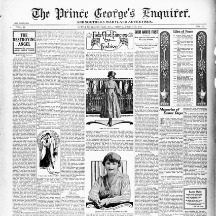“[The] Circuit Court convened here on Monday...This session promises to be a lengthy one and several important cases will be tried, including two murder cases. The case that is attracting the most attention is that of the State against E. P. Gibbs, a prosperous farmer of Queen Anne district. The charge against Gibbs is that he shot and killed a negro named Thomas Turner.”
- Prince George’s Enquirer, October 19, 1906
A few sentences in the July 6, 1906 edition of the Prince George’s Enquirer about the “unfortunate killing of Thomas M. Turner, colored, by Edwin P. Gibbs,” a medical doctor, would never sum up the Black community’s anguish and outrage.
Word had spread rapidly in Queen Anne that morning: “Old man Gibbs had shot and killed him.” Turner, a 40-year-old ex-slave and farmer, cherished the land and worked “from can to can't,” an old saying that means working from when you can see (sunup) to when you can’t (sundown). He was well-known and “held in high esteem,” by Blacks, and even by some whites including Dr. Frederick Sasscer, a wealthy, powerful physician in Upper Marlborough, Maryland.
Turner’s plot of land was on Gibbs’ expansive Hazelwood Estate, which stretched for miles along both sides of the Patuxent River. When he became landlord in 1899, he knew that farming the land would be too much for him to handle alone. He hired farmhands and dictated the terms of sharecropping agreements with those Blacks who had been slaves on the same land that Gibbs would now lease to on his terms.
Like typical contracts of the day, he expected to collect fees and required that a portion of the crops be given to him at the end of harvest. Sharecropping had become a one-sided power play in Maryland and the rest of the United States during Reconstruction, especially when the landowner was White and tenants were Black. The terms of Turner’s lease had been finalized with a previous owner and carried over to Gibbs when he purchased the property. Of importance is that the contract included a duration clause.
Known to be ill-tempered, and antagonistic towards Blacks, over time, Gibbs grew more and more determined to have Turner vacate the land he rented. Not easily intimidated, Turner fought back by filing a lawsuit to have his contract enforced.
In June, Judge George C. Merrick ruled in his favor, citing that Turner had the right to continue farming the land, at least for the term of the lease. Gibbs, the court said, had not given Turner “sufficient legal notice to vacate.” After the court ruling, Turner returned to farming his land, despite Gibbs’ contention that he still had the right to evict him.
Prosperous White Farmer Claims Self-Defense for Killing Negro Named Thomas Turner
Tales from Historic Mount Nebo Series: See Note at the end of this article about this series and additional stories
Tales from Historic Mount Nebo Series: See Note at the end of this article about this series and additional stories
Praising the Past




“[…the death of Thomas Turner] has caused a sensation in the community. The inquest will be held today, after which the real facts of the case may be known.”
- Prince George’s Enquirer, July, 1906
Animosity between the two men intensified. On the morning of July 3, Gibbs learned that Turner was in the field haying and confronted him, enraged. The quarrel over the land abruptly ended with Turner murdered, his two boys standing nearby.
Gibbs turned himself into the authorities in Upper Marlborough at noon that same day, admitting that he had shot Turner two times. He was jailed, reportedly in one of the most confortable cells.
“Mr. E. P. Gibbs was acquitted by a jury in Circuit Court on Friday night of last week to the charge killing Thomas Turner, colored, on July 3rd.”
- Prince George’s Enquirer, October 19, 1906
When the Circuit Court convened in October, 1906, Gibbs plead not guilty, claiming self-defense: “[Turner] was coming toward him with a pitchfork,” he contended. The jury acquitted Gibbs of all charges. On October 12, Gibbs walked away a free man. “It was nothing to kill a black man in Prince George’s County back then, recalled, Harry Brooke Watkins, Turner’s nephew, especially if the murder was committed by a white landlord.” Watkins was nearly 100-years-old when he recalled the story to authors Donald Shomette and Fred Tutman.
From that day forward, no Turner family member ever stepped on the Hazelwood property again. There was even talk that Sasscer mourned Turner’s death and set about to exact retribution.
Tales from Historic Mount Nebo Series: Is an ongoing series of stories about people connected to the historic Mount Nebo African American Episcopal Church, Cemetery, and/or Colored School in Bowie, Maryland. Click the link below for the original story and for links to this and other stories in the series.
Black Lives Matter in Death, Too – Mt. Nebo AME Preserves Historic Cemetery
Advertisers | Contact Us | Events | Links | Media Kit | Our Company | Payments Pier
Press Room | Print Cover Stories Archives | Electronic Issues and Talk Radio Archives | Writer's Guidelines






